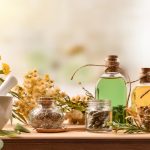9 herbs to improve blood circulation and heart function
 (NaturalHealth365) Herbs have been used for centuries as a tonic and as a remedy for certain heart conditions. It is only in recent years that scientists have begun to acknowledge the power of herbs in reversing disease. Keep in mind, to improve heart function, these herbs should be used as a part of a heart-healthy diet and lifestyle – not a replacement.
(NaturalHealth365) Herbs have been used for centuries as a tonic and as a remedy for certain heart conditions. It is only in recent years that scientists have begun to acknowledge the power of herbs in reversing disease. Keep in mind, to improve heart function, these herbs should be used as a part of a heart-healthy diet and lifestyle – not a replacement.
Editor’s note: Heart disease now kills 31% of all people worldwide … and the root causes are NOT what you think! Click here to discover the truth inside the Cardiovascular Docu-Class, hosted by Jonathan Landsman, creator of NaturalHealth365
Is there a “magic pill” to overcome heart disease?
The answer is obvious: of course not. But, let’s take a closer look at 9 of our favorite herbal remedies for heart health.
1. Hawthorn berry leaf and flowers can strengthen the heart and improve circulation. These berries are packed with heart-healthy compounds like flavonoids, rutin, epicatechin, vitexin, catechin, proanthocyanidins, quercetin hyperoside. These compounds help dilate blood vessels, prevent damage to blood vessels, improve blood flow, and improve heart function. And, yes, they are even considered safe to use with conventional drugs.
2. Bilberry will strengthen blood vessels and capillaries throughout the body. In Europe, bilberry is used as a part of approved treatment to improve certain heart conditions. Studies indicate that bilberries are rich in anthocyanosides, plant pigments, and vitamin C – all of which have excellent antioxidant properties.
In Europe, bilberries have been used to eliminate varicose veins and to improve blood circulation. A 2009 study on rat models showed that bilberry extracts caused a significant decrease in plaque formation and prevented the progression of heart damage.
3. Butcher’s broom tones circulatory tissues throughout the body. It is widely used in the treatment of varicose veins, hemorrhoids, and other circulatory disorders. The major components of butcher’s broom are anthocyanins and ruscogenin – which exhibit significant antioxidant and anti-inflammatory effects crucial for heart health.
4. Ginkgo leaf improves oxygenation and strengthens the cardiovascular system. The active components of ginkgo leaves are the polyphenol flavonoids, proanthocyanidins, and terpene trilactones. According to many studies, ginkgo leaves help treat intermittent claudication or poor circulation in the legs. A meta-analysis of eight randomized studies showed that people taking ginkgo showed improvement in their ability to walk farther when compared to placebo. This study was published in the American Journal of Medicine (2000).
5. Gotu kola leaf improves blood circulation and acts as a heart tonic. Gotu kola has been a mainstay of both the Ayurvedic and Traditional Chinese Medicine (TCM) healing systems. Gotu kola is rich in antioxidants, terpenoids, sesquiterpenes, quercetin, kaempferol, and other flavones.
The terpenoids are the active constituents in Gotu kola – which exert significant anti-inflammatory effects. A 2000 study clearly demonstrated that Gotu kola leaves improved the blood circulation in tiny capillaries and improved the conditions of vascular insufficiency in patients.
6. Motherwort leaf improves cardiac function and circulation. Motherwort has been used since ancient times to alleviate anxiety and improve heart health. Motherwort is rich in the phytonutrient alkaloid leonine, which offers significant benefits to the heart.
Leonine is a mild vasodilator, meaning it increases the size of the blood vessels, which improves the blood flow to the heart and various organs of the body. It is also a diuretic that effectively decreases water retention in the body and naturally lowers high blood pressure.
7. Pleurisy root is a heart tonic, reduces spasms and congestion. The botanical name of the herb is “Asclepias tuberosa” – it is called “pleurisy root” because of its ability to treat pleurisy effectively. It relieves inflammation in the lining of the lungs and thorax and relieves bronchial and pulmonary trouble.
Pleurisy root is rich in cardenolides, the flavonoids rutin and quercetin, kaempferol and lupeol. These compounds have antispasmodic, diuretic, and vasodilation effects throughout the body.
8. Prickly ash bark improves blood flow. It is used as traditional medicine by the Native Americans to treat intestinal cramps, nerve disorders, and inflammatory conditions. The berries have also been used to treat circulatory problems and intermittent claudication.
Prickly ash bark was originally used as an effective remedy for toothaches.
9. Shepherd’s purse leaf supports healthy blood pressure and cholesterol levels. Shepherd’s purse leaves provide vitamins C, A, and K; minerals iron, calcium, sulfur, potassium, and sodium; the flavonoid rutin; and the neurotransmitter acetylcholine.
But wait, that’s not all! Ginger and turmeric also protect your heart health in multiple ways
For example, turmeric and ginger root support healthy cholesterol levels. Turmeric (Curcuma longa) plant and ginger (Zingiber officinale) root are botanically related. They are used as spices in cooking and are also used as a natural remedy to help reduce inflammation.
A 2000 study on mice showed that ginger root effectively brought down high cholesterol levels and exerted heart-protective effects. A recent 2013 study showed that turmeric root was able to improve age-associated artery stiffening, decreased oxidative stress, and collagen formation in mice. Researchers concluded that the active compound curcumin might act as a novel therapy in treating aging arteries in humans and provide heart-protective effects.
As always, we strongly recommend you consult a trusted healthcare provider with experience in herbalism. Bottom line – you can prevent, even reverse heart disease with a comprehensive change in lifestyle and eating habits. No doubt, changing habits are never easy … but, the results are worth the effort.
Sources for this article:



